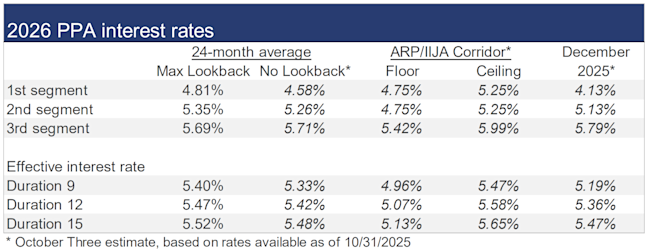Pension Finance Update October 2025
October was the seventh consecutive month of positive news for pension finances this year, driven by continued stock market strength.
October was the seventh consecutive month of positive news for pension finances this year, driven by continued stock market strength. Both model plans we track[1] gained ground last month: traditional Plan A gained 1%, ending the month up almost 7% for the year, while the more conservative Plan B gained a fraction of 1% last month, ending the month up almost 2% through the first ten months of 2025:

Assets
Stocks increased across the board in October; all major indexes have delivered double-digit returns so far this year. A diversified stock portfolio gained more than 2% last month and is now up 21% for the year, led by overseas markets:

Corporate bond yields declined a smidgen (2 basis points) during October, while Treasuries were down a bit more on widening credit spreads. As a result, bonds gained about 1% last month. For the year, most flavors of bonds are up about 7%.
Overall, our traditional 60/40 portfolio gained almost 2% last month and is now up 14% so far this year, while the conservative 20/80 portfolio also gained 1% last month and is now up more than 8% through the first ten months of 2025.
Liabilities
Pension liabilities (for funding, accounting, and de-risking purposes) are driven by market interest rates. The first graph below compares our Aa GAAP spot yield curve at December 31, 2024 and October 31, 2025 (along with the movement in the curve last month). The second graph below shows our estimate of movements in effective GAAP discount rates for pension obligations of various duration during 2025:

Corporate bond yields fell 2 basis points during October, reaching new lows for the year. As a result, pension liabilities increased 1% last month, ending October up 7% for the year so far over a broad range of liability durations.
Summary
Pension finances are now in their seventh consecutive year of improvement; this is truly a historic run that has substantially improved the funded status of virtually all plans. Higher P/E ratios along with interest rates that remain above 5% suggest this streak may be nearing an end. The graphs below show the movement of assets and liabilities for our two model plans through the first ten months of the year:

Looking Ahead
Sustained higher interest rates since late 2022 have substantially diminished the impact of pension funding relief since 2023. Underfunded plans are likely seeing higher required contributions for the next few years.
Interest rates were down a smidgen last month. We expect most pension sponsors will use effective discount rates in the 5.1%-5.5% range to measure pension liabilities right now.
The table below summarizes rates that calendar-year plan sponsors are required to use for IRS funding purposes for 2025, along with estimates for 2026, including the rate “corridor” that applies to the 24-month average rates under funding relief for each segment.


[1] Plan A is a traditional plan (duration 12 at 5.5%) with a 60/40 asset allocation, while Plan B is a largely retired plan (duration 9 at 5.5%) with a 20/80 allocation with a greater emphasis on corporate and long-duration bonds. We assume overhead expenses of 1% of plan assets per year, and we assume the plans are 100% funded at the beginning of the year and ignore benefit accruals, contributions, and benefit payments in order to isolate the financial performance of plan assets versus liabilities.
